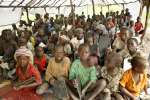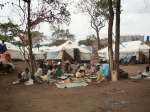Clashes in Central African Republic town of Bambari displaces thousands
Press Releases, 27 August 2015
BANGUI, 27 Aug – Clashes between rival militias in the past few days have forced several thousand people to flee their homes in the Central African Republic town of Bambari. The situation began to ease on Thursday but UNHCR staff say Bambari remains very tense and they fear the situation could deteriorate again.
"We are extremely concerned by the mounting violence in Bambari and its impact on the civilian population. Our staff have reported the displacement of people who are extremely frightened," Kouassi Lazare Etien, UNHCR representative in CAR, said earlier Thursday. He added that UNHCR was also worried about hundreds of Sudanese refugees "trapped in a refugee camp [near Bambari] and at high risk of attacks."
Before this latest flare-up in violence, more than 8,000 people (2,000 families) had returned to their homes in Bambari since last May as a result of mediation and reconciliation initiatives between communities and an improvement in the security situation in the town in south-central CAR. They had fled to escape violence in early 2014. However, fresh fighting between rival militia forces erupted on August 20 and triggered new waves of displacement.
The Notre-Dame-de-la-Victoire site was hosting some 4,250 internally displaced people (IDP), but by Tuesday it was almost empty. UNHCR staff said they had seen people fleeing to three other sites – Sangaris, Aviation and Site Aternatif.
They added that a spontaneous IDP site had sprung up inside the Bambari compound of the UN peace-keeping force (MINUSCA). UNHCR's partner, the National Refugee Commission, had registered about 3,000 IDPs in the MINUSCA compound as of Tuesday. But conditions are dire at the site, a former cotton factory with no sanitation facilities and limited access to water and shelter.
UNHCR is now able to move around Bambari and is trying to assess the total number of newly displaced. The tension remains with armed groups in control of the streets.
UNHCR is also worried about the safety of almost 1,859 Sudanese in Pladama Ouaka refugee camp, which is located 12 kilometres from Bambari. The road leading to the camp had been inaccessible since the weekend, but a UNHCR team escorted by MINUSCA reached the camp on Wednesday.
The refugees told UNHCR staff that they had not been directly affected by the clashes in Bambari, but they called for tightened security as the camp is located in an exposed area. They said they had seen many families from the town fleeing with their belongings.
UNHCR partner, the International Medical Corps, has trained refugees in the camp in basic health care interventions. In the absence of IMC medical staff, the refugee attendants have access to medicines and medical supplies in the camp's health post so basic health services are available.
The trouble in Bambari erupted after a 19-year-old Muslim was killed in the city and beheaded by alleged anti-Balaka fighters. This triggered violent reprisal attacks between the two communities in Bambari, which have left at least 10 people dead and many injured, including ICRC (International Committee of the Red Cross) staff.
UN security officials have reported a build-up of armed militia forces in the city. They say the population and aid workers were isolated and inaccessible, but a humanitarian corridor has been opened to the airport since Tuesday following negotiations between MINUSCA and the rival militia groups.
For more information on this topic, please contact:
- In Bangui, Dalia Al Achi on mobile +236 72675186

















































